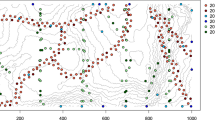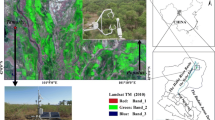Abstract
In several areas in Northeast Thailand, evergreen and deciduous forests coexist under uniform climatic conditions. To identify the factors that determine the distribution of these different forest types, we compared soil depth and soil physical properties between evergreen and deciduous forests, and monitored soil moisture conditions for a year in both forest types at the Sakaerat Environmental Research Station. The soil was significantly deeper under the evergreen forests (mean 97 cm) than under the deciduous forest (mean 64 cm). The soil under the evergreen forests retained much more water throughout the year than the soil under the deciduous forest, and there was also a clear tendency for the evergreen forests to occur in ravine areas, regardless of soil depth. It is possible that the evergreen trees can maintain transpiration during the dry season on thicker soils or in ravine areas, whereas shallower soils cannot provide enough water for these trees to maintain their evapotranspiration during the dry period. From the present study, we showed that soil water availability could be a significant factor determining the distribution of the deciduous and evergreen forests in our catchments.






Similar content being viewed by others
References
Aerts R (1995) The advantages of being evergreen. Trends Ecol Evol 10:402–407
Baker TR, Burslem DFRP, Swaine MD (2003) Associations between tree growth, soil fertility and water availability at local and regional scales in Ghanaian tropical rain forest. J Trop Ecol 19:109–125
Beven KJ, Kirkby MJ (1979) A physically based, variable contributing area model of basin hydrology. Hydrol Sci Bull 24:43–69
Borchert R (1994) Soil and stem water storage determine phenology and distribution of tropical dry forest trees. Ecology 75:1437–1449
Bos F, Thunduan V (1968) Detailed soil survey of the north-eastern portion of ASRCT Sakaerat Experimental Station. ASRCT Report no. 1. ASRCT, Bangkok
Cassel DK, Nielsen DR (1986) Field capacity and available water capacity. In: Klute A (ed) Method of soil analysis: physical and mineralogical methods. American Society of Agronomy, Madison, pp 901–926
Daws MI, Mullins CE, Burslem DFRP, Paton SR, Dalling JW (2002) Topographic position affects the water regime in a semideciduous tropical forest in Panama. Plant Soil 238:79–90
FAO/UNESCO (1974) Soil map of the world, vol 9: Southeast Asia. UNESCO, Paris
Flint A, Flint L (2002) Particle density. In: Dane J, Topp G (eds) Methods of soil analysis, part 4: physical methods. Soil Science Society of America, Madison, pp 229–240
Grunwald S, Lowery B, Rooney DJ, McSweeney K (2001) Profile cone penetrometer data used to distinguish between soil materials. Soil Tillage Res 62:27–40
Ishida A, Diloksumpun S, Ladpala P, Staporn D, Panuthai S, Gamo M, Yazaki K, Ishizuka M, Puangchit L (2006) Contrasting seasonal leaf habits of canopy trees between tropical dry-deciduous and evergreen forests in Thailand. Tree Physiol 26:643–656
Jury WA, Horton R (2006) Soil physics, 6th edn. Tsukiji Shokan, Tokyo (Jap. transl.)
Kanzaki M, Yoda K, Dhanmanonda P (1995) Mosaic structure and tree growth pattern in a monodominant tropical seasonal evergreen forest in Thailand. In: Box EO, Peet RK, Masuzawa T, Yamada I, Fujiwara K, Maycock PF (eds) Vegetation science in forestry. Kluwer, Dordrecht, pp 495–513
Kumagai T, Tateishi M, Shimizu T, Otsuki K (2008) Transpiration and canopy conductance at two slope positions in a Japanese cedar forest watershed. Agric For Meteorol 148:1444–1455
Lal R (1996) Deforestation and land-use effects on soil degradation and rehabilitation in western Nigeria. I. Soil physical and hydrological properties. Land Degrad Dev 7:19–45
Malhi Y, Wright J (2004) Spatial patterns and recent trends in the climate of tropical rainforest regions. Philos Trans R Soc Lond B Biol Sci 359:311–329
Methikul A, Silpalit M (1968) Reconnaissance geological survey of the ASRCT Sakaerat Experimental Station. ASRCT Report no. 4. ASRCT, Bangkok
Moormann FR, Rojanasoonthorn S (1972) The soils of Kingdom of Thailand: explanatory text of the general map. Department of Loyal Land Development, Bangkok
Murata N, Ohta S, Ishida A, Kanzaki M, Wachirinrat C, Artchawakom T, Sase H (2009) Comparison of soil depths between evergreen and deciduous forests as a determinant of their distribution, Northeast Thailand. J For Res 14:212–220
Ohnuki Y, Yoshinaga S, Noguchi S (1999) Distribution and physical properties of colluvium and saprolite in unchannelized valleys in Tsukuba experimental basin, Japan. J For Res 4:207–215
Ohnuki Y, Kimhean C, Shinomiya Y, Toriyama J (2008) Distribution and characteristics of soil thickness and effects upon water storage in forested areas of Cambodia. Hydrol Process 22:1272–1280
Onda Y (1992) Influence of water storage capacity in the regolith zone on hydrological characteristics, slope processes and slope form. Z Geomorphol 36:165–178
R Development Core Team (2010) R: a language and environment for statistical computing. R Foundation for Statistical Computing, Vienna
Sahunalu P, Dhanmanonda P (1995) Structure and dynamics of dry dipterocarp forest, Sakaerat, northeastern Thailand. In: Box EO, Peet RK, Masuzawa T, Yamada I, Fujiwara K, Maycock PF (eds) Vegetation science in forestry. Kluwer, Dordrecht, pp 465–494
Sakurai K, Tanaka S, Ishizuka S, Kanzaki M (1998) Differences in soil properties of dry evergreen and dry deciduous forests in the Sakaerat environmental research station. Tropics 8:61–80
Saruwatari T (2006) Forest dynamics for 50 years analyzed with aerial photographs in the Sakaerat Environmental Research Station, northeast Thailand. MS thesis, Kyoto University (in Japanese)
Sukapanpotharam V (1979) Scarab beetle communities in deciduous dipterocarp and dry evergreen forests in northeastern Thailand. Bull Nat Hist Siam Soc 28:55–100
Tongyai P (1980) The Sakaerat environmental research station. Thailand MAB Committee, Bangkok
Toriyama J, Ohta S, Araki M, Kanzaki M, Khorn S, Pith P, Lim S, Pol S (2008) Comparison of soil physical properties in evergreen and deciduous forests in central Cambodia. J For Res 13:15–24
van Tromp-Meerveld HJ, McDonnell JJ (2006) On the interrelations between topography, soil depth, soil moisture, transpiration rates and species distribution at the hillslope scale. Adv Water Resour 29:293–310
Yamakura T (1987) An empirical approach to the analysis of forest stratification, I: proposed graphical method derived by using an empirical distribution function. J Plant Res 100:109–128
Yoshifuji N, Tanaka N, Tantasirin C, Suzuki M (2007) Factors affecting interannual variability in transpiration in a tropical seasonal forest in northern Thailand: growing season length and soil drought. In: Sawada H, Araki M, Chappell NA, LaFrankie JV, Shimizu A (eds) Forest environments in the Mekong river basin. Springer, Tokyo, pp 56–66
Acknowledgments
We thank all the staff members of the Sakaerat Environmental Research Station who kindly assisted our fieldwork and the staff members of Kansai Research Center, Forestry and Forest Products Research Institute, for the help with the analysis of soil physical properties in the laboratory. This study was supported by grants-in-aid from the Japan Society for the Promotion of Science (18255011) and the Japanese Ministry of the Environment (C-05-052).
Author information
Authors and Affiliations
Corresponding author
About this article
Cite this article
Murata, N., Ohta, S., Ishida, A. et al. Soil depth and soil water regime in a catchment where tropical dry evergreen and deciduous forests coexist. J For Res 17, 37–44 (2012). https://doi.org/10.1007/s10310-010-0248-z
Received:
Accepted:
Published:
Issue Date:
DOI: https://doi.org/10.1007/s10310-010-0248-z




